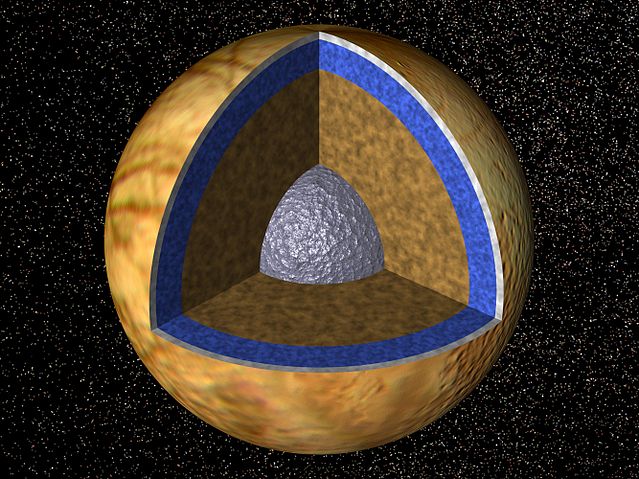 |
This is a file from the Wikimedia Commons. Information from its description page there is shown below.
Commons is a freely licensed media file repository. You can help.
|
- original description: Cutaway view of the possible internal structure of Europa The surface of the satellite is a mosaic of images obtained in 1979 by NASA's Voyager spacecraft. The interior characteristics are inferred from gravity field and magnetic field measurements by NASA's Galileo spacecraft. Europa's radius is 1565 km, not too much smaller than our Moon's radius. Europa has a metallic (iron, nickel) core (shown in gray) drawn to the correct relative size. The core is surrounded by a rock shell (shown in brown). The rock layer of Europa (drawn to correct relative scale) is in turn surrounded by a shell of water in ice or liquid form (shown in blue and white and drawn to the correct relative scale). The surface layer of Europa is shown as white to indicate that it may differ from the underlying layers. Galileo images of Europa suggest that a liquid water ocean might now underlie a surface ice layer several to ten kilometers thick. However, this evidence is also consistent with the existence of a liquid water ocean in the past. It is not certain if there is a liquid water ocean on Europa at present.
- source: http://photojournal.jpl.nasa.gov/catalog/PIA01130
| Public domainPublic domainfalsefalse |
 |
This file is in the public domain because it was solely created by NASA. NASA copyright policy states that "NASA material is not protected by copyright unless noted". (See Template:PD-USGov, NASA copyright policy page or JPL Image Use Policy.) |
|
|
|
Warnings:
- Use of NASA logos, insignia and emblems are restricted per US law 14 CFR 1221.
- The NASA website hosts a large number of images from the Soviet/ Russian space agency, and other non-American space agencies. These are not necessarily in the public domain.
- Materials based on Hubble Space Telescope data may be copyrighted if they are not explicitly produced by the STScI. See also {{ PD-Hubble}} and {{ Cc-Hubble}}.
- The SOHO (ESA & NASA) joint project implies that all materials created by its probe are copyrighted and require permission for commercial non-educational use.
- Images featured on the Astronomy Picture of the Day (APOD) web site may be copyrighted.
|
File usage
The following pages on Schools Wikipedia link to this image (list may be incomplete):
Wikipedia for Schools is designed to make learning fun and easy. More than 2 million people benefit from the global charity work of SOS Children, and our work in 133 countries around the world is vital to ensuring a better future for vulnerable children. Try to find out how you can help children in other countries on our web site.





